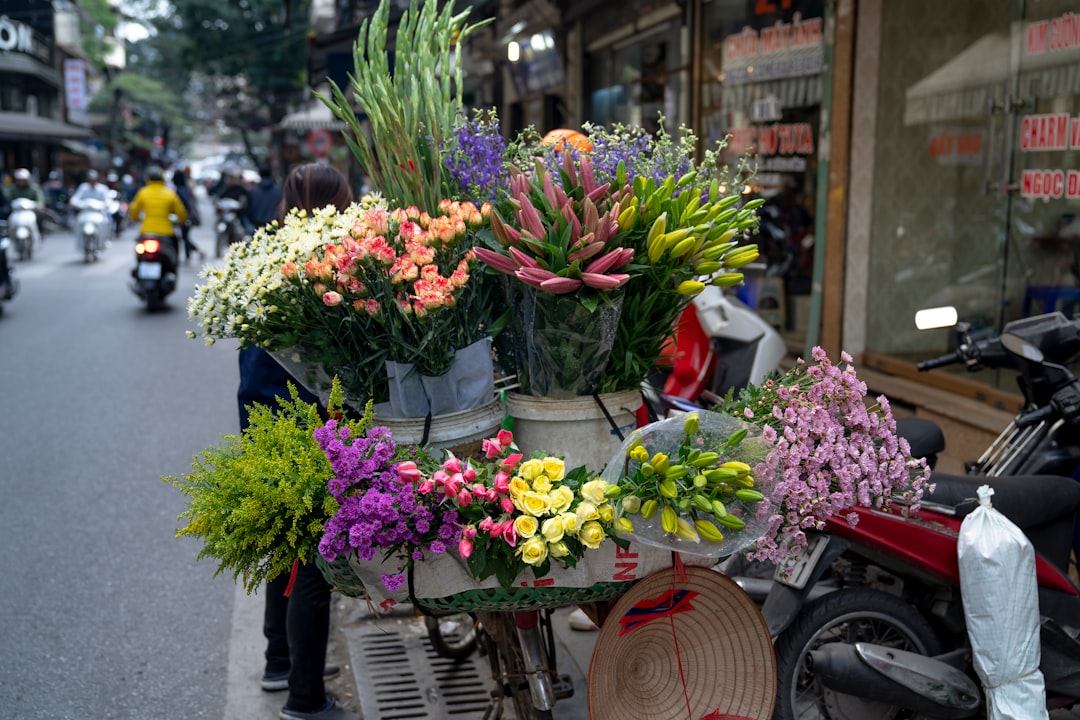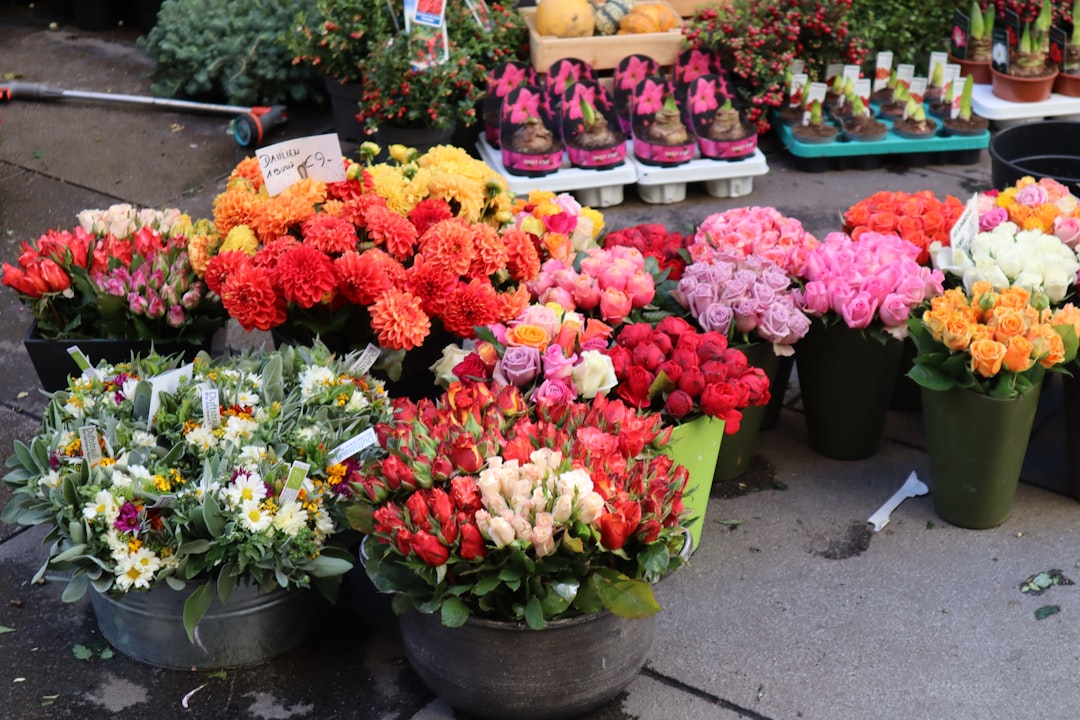

Engage prospects with a scan and streamline customer engagement with FREE QR code marketing tools by Sona – no strings attached!
Create a Free QR CodeFree consultation

No commitment

Engage prospects with a scan and streamline customer engagement with FREE QR code marketing tools by Sona – no strings attached!
Create a Free QR CodeFree consultation

No commitment
In today’s digitally driven world, QR codes have evolved into a strategic tool for QR marketing that connects offline engagement to immediate online action. For florist supply businesses, QR codes provide a simple, scalable way to move buyers from paper catalogs, packaging, invoices, and trade show signage into product pages, reorder flows, and forms. The result is higher engagement, measurable attribution, and sales processes that no longer rely on guesswork.
When QR codes are embedded into everyday touchpoints, every scan becomes a data point. Florist suppliers can track which SKUs generate interest, identify which shops and event planners are reordering, and personalize follow-up based on the item scanned and the context of the interaction. With dynamic QR codes that can be updated without reprinting, this strategy lowers friction for buyers while giving teams the analytics needed to invest in the highest-performing channels and accounts.
By transforming analog interactions into digital journeys, florist supply businesses close attribution gaps, reclaim missed opportunities, and create a more responsive customer experience that compounds over time. See this guide for florists for industry best practices.

Many florist suppliers struggle to convert offline interactions into trackable, repeatable revenue. Buyers who browse paper catalogs, collect care tags, or snap photos of pricing sheets often remain invisible to your CRM. QR codes bridge this gap by connecting every physical asset to a conversion-oriented digital destination. When each scan is tracked, you gain insight into product interest, channel performance, and account readiness to buy. Explore Sona QR’s use case library for examples.
Replacing analog processes with QR-enabled workflows pays dividends. Printed order forms become mobile-friendly reorder pages, jobsite signage becomes a sign-up gateway for delivery updates, and care instructions transform into multimedia guides with upsell prompts. Centralized QR platforms like Sona QR let you create unique codes, route scans to the right destination, and sync activity with CRM and analytics tools so sales teams can prioritize the highest-intent prospects.
Digitizing analog touchpoints with QR codes gives your team visibility into demand signals that used to be hidden. A unified platform and thoughtful placement strategy ensure that every scan translates into a next step, every next step is measured, and every high-value interaction is routed into your pipeline.

Florist suppliers face persistent challenges such as weak attribution, missed follow-up on high-intent interactions, and limited visibility into which materials or channels actually influence purchasing decisions. QR codes solve these problems by creating a direct digital bridge at the exact moment interest peaks, such as when a buyer reads a care tag or compares items in a catalog. Innovations like QR zipper show new ways to connect packaging to digital experiences.
Beyond convenience, QR codes create a measurable customer journey. When a shop owner scans a code on floral foam packaging, you can route them to a reorder page with their usual case quantity and price tiers. When an event planner scans a catalog page for ribbon assortments, you can prompt a sample request or a bulk inquiry. This mix of speed, flexibility, and attribution converts curiosity into action and turns fragmented offline interactions into data you can act on.
For florist supply businesses, these advantages translate into better customer experiences and sharper allocation of marketing and sales effort, which is the foundation for sustainable growth.

Florist suppliers benefit from QR code formats that match specific workflows and buyer needs. Choosing the right format and destination reduces friction and boosts conversion.
Choose dynamic QR codes when you need to change destinations without reprinting, capture detailed analytics, create audience segments, and integrate with your CRM. Static codes can work for fixed content such as a PDF of care instructions, but dynamic codes are the better default for campaigns that require measurement and optimization.
The florist supply buying cycle includes many offline moments that are perfect for QR activation. The key is to place codes where intent is high and the next step is clear.
Turn every high-traffic printed asset into a measurable touchpoint. The data you collect will reveal which placements deliver the most value and which buyer segments are primed for conversion.

Targeted QR applications help florist suppliers streamline operations and unlock revenue from interactions that used to be anonymous. Start with high-intent scenarios and design simple scans that remove friction.
These use cases convert routine materials into conversion engines while giving your team the attribution required to invest with confidence.
Every scan carries context such as channel, timing, and product interest. By deploying unique codes across materials and locations, you can segment audiences automatically and deliver targeted follow-up that feels relevant, not generic.
Start by mapping scan points to the stages of your buyer journey. An awareness scan might come from a trade show banner for new brands, consideration from a catalog page for vases and supplies, and conversion from an invoice or bin label. Feed these signals into your CRM and ad platforms so you can nurture each group differently and escalate sales outreach when intent is highest. See Sona’s retargeting playbook for activation ideas.
For florist suppliers, segment distinctions often include independent florists versus multi-location retailers, wedding and event planners versus everyday retail, and wholesale distributors versus end consumers. These profiles respond to different messages, so let the scan context guide your cadence and creative.
QR codes turn disconnected channels into a cohesive system that captures interest, educates buyers, and accelerates orders. By unifying print, in-store, events, social, and direct mail around scannable entry points, you create a consistent experience that tracks every step.
The practical benefit is a single data layer across offline media that used to be dark. Codes on catalogs, invoices, receipts, and signage tell you what buyers engage with and when. With a centralized platform like Sona QR, you can manage destinations, monitor performance, and sync scan data to your CRM and ad platforms for timely, relevant follow-up.
By connecting these channels with QR codes, you create an offline onramp into your digital marketing engine and capture data that informs smarter decisions across the entire funnel.
A disciplined approach helps QR campaigns launch smoothly and scale efficiently. Begin with a clear business goal, choose the right QR type, design for scannability, and measure what matters. Use the following steps to structure your rollout.
Clarify what problem you want to solve and how a QR journey can remove friction. Start with one or two high-intent scenarios such as Scan to reorder on invoices or Scan for show special at a trade event. Align each use case with a measurable outcome like completed reorders or booked consultations.
Choose between static and dynamic codes. Static codes work for unchanging destinations such as a fixed PDF, while dynamic codes allow destination edits, deep analytics, and audience building without reprinting. Most sales and marketing campaigns should default to dynamic.
Design for visibility and clarity. Larger codes, contrast backgrounds, and clear calls to action increase scan rates. Include your logo or brand colors to build trust, then test thoroughly to avoid surprises.
Roll out codes on the assets that see the most qualified traffic. For florist suppliers, strong candidates include catalogs, invoices, bin labels, packaging, and event signage. Match placement to the buyer’s context and likely next step.
Analytics are the engine of continuous improvement. Monitor scan volume, scan-to-click rates, and conversion to the desired action. Iterate on creative, placement, and destinations based on what the data reveals.
End-to-end attribution is one of the most valuable outcomes of a QR strategy. Scans give you the who, where, and when; combined with your CRM and ecommerce data, you can see which codes lead to orders, which placements attract the highest-value customers, and which products spark repeat purchases. This level of visibility turns QR from a convenience feature into a performance channel.
Without a connected analytics stack, scan data often sits in a silo. Use a platform that captures scan details and pushes them into your marketing and sales systems. With Sona QR and Sona.com, you can track engagement by code, attribute revenue, and understand how QR activity fits within larger buyer journeys that include site visits, email clicks, and sales touches.
When scans translate into attributed revenue, QR codes become a strategic lever that complements your broader acquisition and retention efforts.
Scaling QR performance depends on consistent execution and messaging that tells buyers exactly what they get when they scan. Focus on placement quality, benefit-led CTAs, and workflow automation so every scan triggers a meaningful next step.
Florist suppliers can boost conversion by aligning QR experiences to common buyer tasks. Make it easy to reorder staples from the bench, request bulk quotes during seasonal spikes, and access care content without calling support. Then synchronize scan data with sales outreach so the highest-intent accounts receive timely attention.
Creative deployment examples include QR codes on loyalty punch cards that link to exclusive seasonal bundles for independent florists, and QR codes on invoices that pre-fill the customer’s last order for one-tap reordering during busy periods.

Practical wins across the florist supply sector showcase how QR codes turn everyday materials into growth engines. The most effective programs pair clear value propositions with thoughtful placement and a data strategy that attributes revenue to the right touchpoints.
Teams that lean into dynamic codes consistently find new ways to engage and measure. A single print run of catalogs can fuel a year of campaigns by refreshing destinations for seasonal products, and a warehouse relabeling project can double as a conversion optimization initiative when every aisle and bin is scannable.
Use these patterns as inspiration to design your own QR program. The common thread is a scanner’s promise that is fulfilled immediately and tracked rigorously.
Successful QR programs are built on clear CTAs, clean data, and reliable scanning experiences. The most common mistakes are easy to avoid with deliberate planning and testing.
First, resist the temptation to bury codes in dense designs or to assume that customers understand what they will get. Visibility, contrast, and a plain-language CTA drive scan rates. Second, never send scanners to generic homepages. Deep-link to the exact action promised, then measure and iterate.
For florist supply businesses, QR codes have moved from novelty to necessity. They give you a way to turn every printed asset, package, and event into a digital entry point that captures demand at the source. More importantly, they transform once-invisible interactions into measurable outcomes, making it clear which products, placements, and messages drive results.
When every scan triggers a relevant next step, you accelerate reorders, improve service experiences, and give sales teams a steady stream of high-intent signals. With dynamic codes, robust analytics, and CRM integration, you can test, learn, and optimize continuously, ensuring that marketing and operations work in tandem to grow revenue.
Sona QR provides the infrastructure to build and scale this strategy. Generate dynamic codes, manage destinations, track scans by channel and device, and sync activity with your CRM and ad platforms. Pair Sona QR with Sona.com for multi-touch attribution and identity resolution that connects scans to revenue. Start small with your highest-intent use case, measure rigorously, and expand to every touchpoint that matters. Start creating QR codes for free.
Adopting QR codes today positions florist suppliers for a future where every high-value interaction is captured, every promising lead is nurtured, and every campaign is optimized by real data. The opportunity is simple and significant: turn daily operations into a data-rich growth engine and convert more moments of interest into measurable sales.
QR codes have transformed florist supply businesses from traditional marketing methods into dynamic, measurable growth drivers. Whether it’s attracting new customers, enhancing client interactions, or streamlining order processes, QR codes enable instant, mobile-friendly engagement and provide real-time data to turn every marketing material into a powerful conversion tool. Imagine knowing exactly which product catalogs or in-store displays lead to more orders—and being able to optimize your campaigns instantly.
With Sona QR, you can create dynamic, trackable QR codes in seconds, update campaigns without the cost of reprinting, and link every scan directly to sales performance. No more guessing which efforts pay off—just smarter strategies that boost revenue and deepen customer loyalty.
Start for free with Sona QR today and transform every scan into a loyal customer, a completed order, or a flourishing partnership.
QR codes improve customer experience by providing instant access to product pages, reorder flows, care instructions, and multimedia guides, reducing friction and enabling quick actions at the moment of need.
Benefits include seamless offline-to-online conversion, measurable customer journeys, real-time tracking and attribution, dynamic content updates without reprinting, cost efficiency, and enhanced sales and marketing alignment.
QR codes boost sales by enabling faster reorders, capturing high-intent buyer interactions, facilitating event registrations and sample requests, providing personalized follow-up, and turning offline touchpoints into measurable conversion opportunities.
QR codes can link to product pages, reorder forms, care and how-to videos, vCards for sales reps, SMS or email pre-filled messages, Wi-Fi access for events, app downloads, and customer portals.
Suppliers should choose high-impact use cases, select dynamic QR codes for flexibility and analytics, design codes with clear calls to action and good visibility, deploy codes across catalogs, packaging, signage, and invoices, and track performance to optimize results.
Codes should be placed on catalogs, brochures, product packaging, supply labels, point-of-sale displays, trade show materials, invoices, direct mail inserts, and event signage where buyer intent is high and next steps are clear.
QR codes provide data on scan volume, location, device, campaign source, buyer behavior, and conversion events, which can be integrated with CRM and sales platforms for real-time attribution and performance optimization.
Avoid placing codes in hard-to-scan areas, using generic landing pages, insufficient calls to action, low contrast designs, and neglecting staff training or privacy compliance.
Dynamic QR codes allow destination updates without reprinting, enable detailed analytics, support audience segmentation, and facilitate integration with CRM systems for ongoing campaign optimization.
By assigning unique codes by buyer journey stage and action, scan data can be segmented by intent and context, enabling targeted follow-up via email, SMS, or paid ads that align with each customer’s needs.
Use Sona QR's trackable codes to improve customer acquisition and engagement today.
Create Your FREE Trackable QR Code in SecondsJoin results-focused teams combining Sona Platform automation with advanced Google Ads strategies to scale lead generation

Connect your existing CRM

Free Account Enrichment

No setup fees
No commitment required

Free consultation

Get a custom Google Ads roadmap for your business






Launch campaigns that generate qualified leads in 30 days or less.
